KARAKTERISTIK MUTU BAKSO BELUT (Monopterus albus) DENGAN VARIASI SUBSTITUSI TEMPE
CHARACTERISTICS OF QUALITY EEL (Monopterus albus) MEATBALLS WITH TEMPE SUBSTITUTION VARIATIONS
Abstract
Meatballs are a type of processed food made from chopped fresh meat, fillers, binders and spices. Besides beef, meatballs can also be made from eel meat because eel meat has a high enough protein. Tempe can be used as a substitute for eel meat because the price of tempe is more affordable and the protein content is also quite high. The purpose of this study was to analyze the effect of the composition of eel and tempe on the protein and organoleptic content of eel meatballs. The results of the analysis showed that the more use of tempe composition, the meatball protein content increased by 19.27%. The results of organoleptic analysis of the color, taste, aroma and texture of meatballs with the treatment of eel and tempe composition showed significant differences. The more the use of tempe composition the assessment of color, taste, flavour and texture is decrease. The results of the average color oranoleptic are between 3,75 (likes) to 4,25 (likes), the average organoleptic taste is between 3,65 (likes) to 4,05 (likes), the average organoleptic flavour is between 3,35 (rather likes) to 4,30 (likes) and organoleptic texture averages between 3,65 (likes) to 4,20 (likes).
Kata Kunci : meatballs; eel meat; tempe
Downloads
References
Andayani, R.Y. 1999. Standarisasi mutu bakso berdasarkan penilaian konsumen (studi kasus bakso di wilayah DKI Jakarta). Fakultas Teknologi Pertanian Institut Pertanian Bogor, Bogor. Skripsi.
Astuti, M., M Andreanyta, S.F. Dalais, M.L. Wahlqvist. 2000. Tempe, a Nutritious and Healthy Food from Indonesia. Asia Pacific Journal of Clinic and Nutrition. Vol. 9
Felicia. 2010. Penggunaan pati sagu termodifikasi dengan heat moisture treatment (HMT) untuk meningkatkan kualitas tekstur bakso daging sapi. Skripsi. Institut Pertanian Bogor. Bogor
Meilgaard. 2000. Sensory Evalution Teechniques. CRC. Boston.
Nout, M.J.R. and Kiers, J.L. 2005. Tempe fermentation, innovationand functionality: update into the third milenium. Journal of Applied Microbiolog. 98: 789-805
Ruslan, Roy. 2009. Buku Pintar Budidaya dan Bisnis Belut. Agromedia Pustaka. Jakarta
Sari, H.A dan Widjanarko, S.M. 2015 Karakteristik Kimia Bakso Sapi (Kajian Proporsi Tepung Tapioka: Tepung Porang dan Penambahan NaCl). Jurnal Pangan dan Agroindustri Vol. 3 No 3 p.784-792, Juli 2015
Sari, K, P., Jamaluddin, P dan Sukainah, A. 2016. Fortifikasi Tempe Berbahan Dasar Kedelai dan Biji Nangka. Jurnal Pendidikan Teknologi Pertanian, Vol. 2
Sudarmadji, S., Haryono B., dan Suhardi. 1997. Prosedur untuk Uji Analisis Makanan dan Pertanian. Liberty. Yogyakarta.
Soekarto, S.T. 1985. Penilaian Organoleptik. Bhatara Karya Aksara. Jakarta
Sudrajat, G. 2007. Sifat Fisik Dan Organoleptik Bakso Daging Sapi dan Daging Kerbau Dengan Penambahan Karagenan dan Khitosan. Skripsi. Fakultas Pertanian, Institut Pertanian Bogor. Bogor
Suyatno. 2010. DKBM-Indonesia. http://suyatno.blog.undip.ac.id/files/2010/ 04/ DKBM-Indonesia.pdf. Diakses : 29 Maret 2019.
Wibowo S. 2006. Pembuatan Bakso Ikan dan Bakso Daging. Penebar Swadaya. Jakarta.
Wibowo, 2009, Bakso dan jenis olahan Universitas Sumatera Utara PT.Gramedia Pustaka Utama, Jakarta.
Winarno FG. 2009. Kimia Pangan dan Gizi. Jakarta (ID): M-Brio Press
Author retains the copyright and grants the journal the right of first publication of the work simultaneously licensed under the Creative Commons Attribution-ShareAlike 4.0 License that allows others to share the work with an acknowledgement of the work's authorship and initial publication in this journal











